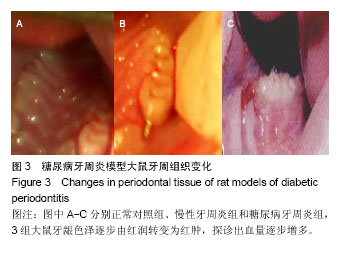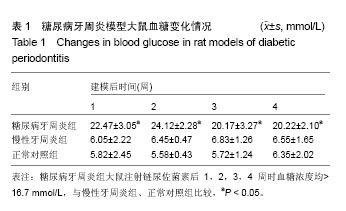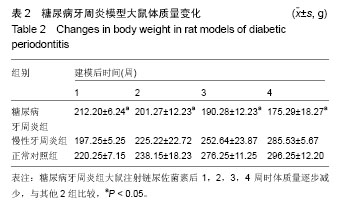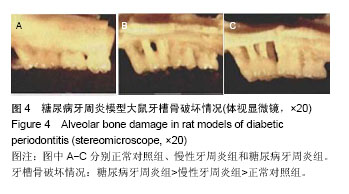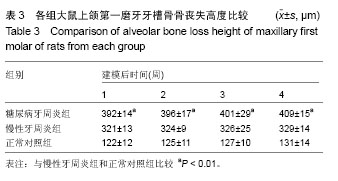| [1] Eriksen CG, Olsen H, Husted LB, et al. The expression of IL-6 by osteoblasts is increased in healthy elderly individuals: stimulated proliferation and differentiation are unaffected by age. Calcif Tissue Int. 2010;87(5):414-423.
[2] Jurado S, Garcia-Giralt N, Díez-Pérez A, et al. Effect of IL-1beta, PGE(2), and TGF-beta1 on the expression of OPG and RANKL in normal and osteoporotic primary human osteoblasts. J Cell Biochem. 2010;110(2):304-310.
[3] Loe H. Periodontal disease The sixth complication and diabetes mellitus. Diabetes Care. 1993;16(1)329.
[4] LallaE, Lamster IB, Feit M, et al. Block ade of RAGE suppresses peri-odontitis-associated bone loss in diabetic mice. J Clin Invest. 2000;105(8):1117.
[5] Mahamed DA, Marleau A, Alnaeeli M, et al. G(-) anaerobes-reactive CD4(+) T-cells trigger RANKL-mediated enhanced alveolar bone loss in diabetic NOD mice. Diabetes. 2005;54(5):1477.
[6] The Ministry of Science and Technology of the People’s Republic of China. Guidance Suggestions for the Care and Use of Laboratory Animals. 2006-09-30.
[7] 郭子杰,戴永雨,栾文明,等.大鼠后牙牙槽骨吸收模型的建立及破骨细胞的鉴定[J].中国骨质疏松杂志2007,13(2):82-85
[8] 赵戬,马勇强,王宏岩,等.大鼠实验性牙周炎模型牙槽骨破坏研究[J].中国实用口腔科杂志,2012,3(5):155-158.
[9] 曹晓丽,张云,李玉明,等.糖尿病牙周炎模型大鼠的建立[J].天津医科大学学报,2010,3(9):467-469.
[10] 于静,谢景朝.实验性糖尿病牙周炎大鼠牙周组织形态结构的变化[J].疑难病杂志,2010,6(6):424-426.
[11] 张炜真,于世凤,郑麟蕃.糖尿病大鼠牙槽骨骨密度的变化[J].中华口腔医学杂志,1997,32(1):49-51.
[12] 于世凤,晓敏.牙周炎动物模型建立的技术关键[J].周病学杂志, 1999,9(1):89-91.
[13] Weinberg MA, Bral M. Laboratory animal models in periodontology. Clin Periodontol. 1999;26:335-340.
[14] Caillon P, Saffar JL. Improvement of gingival and alveolar bone status in periodontitis-affected hamsters treated with 15-methyl prostaglandin E1. Periodont Res. 1994;2(2): 138-145.
[15] Biancu S, Ericsson I, Lindhe J. Periodontal ligment tissue reaction to trauma and gingival inflammation. An experimental study in the beagledog. Clin Periodontol. 1995,22(10): 772-779.
[16] Chang KM, Ramamurthy NS. Tetracyclines inhibit porphyromonas gingivalis-induced alveolar bone loss in rats by a non-antimicrobial mechanism. J Peripdont Res. 1994; 29(4):242-249.
[17] Fischer RG, Kling B. Clinical and histological evaluation of ligature-induced periodontitis in the domestic ferret. Clin Periodont. 1994;21(4):230-239.
[18] Brunsvold MA, Chaves ES, Kornman KS, et al. effect of a bisphosphonate on experimental periodontitis in monkeys. Periodontol. 1992;63(10):825-830.
[19] Smith MA, Collins JG. Changes in inflammatory mediators in experimental periodontitis in the rhesus monkey. Infect Immun. 1993;61(4):1453-1459.
[20] 吴亚菲,赵筱芩,陈宇,等.不同方法建立大鼠实验性牙周炎模型的比较研究[J].四川大学学报,2003,34(4):742-745.
[21] Hou JC, Zemicke RF, Barnard fIJ. Experimental diabetes Insulintl eatment,and femoral neck morphology and biomechanics in rats. Clin Orthop Relat Res. 1991;(264): 278-285.
[22] Yoshida-Minami I, Suzuki A. Alveolar bone loss in rats infected with a strain of Prevotella intermedia and Fusobacterium nucleatum isolated from a child with prepubertalperiodontitis.Periodontol. 1997;68(1):12-17.
[23] 张颖丽,张莉,高文信,等.牙周炎动物模型的研究[J].白求恩医科大学学报,2001,27(6):611-613.
[24] 罗云纲,杨涛,许力强,等.牙周炎动物模型的建立[J].吉林大学学报(医学版),2004,30(2):230-232.
[25] Li J, Liu Y, Ren X, et al. Effect of oral intervention on matrix metalloproteinase-2, 9 expression in carotid arteries and serum interleukin-6 in rats with chronic periodontitis. Zhonghua Kou Qiang Yi Xue Za Zhi. 2014;49(9):554-559.
[26] Yang H, Aprecio RM, Zhou X, et al. Therapeutic effect of TSG-6 engineered iPSC-derived MSCs on experimental periodontitis in rats: a pilot study. PLoS One. 2014;9(6): e100285.
[27] Liu Y, Li J, Ren X, et al. Influence of periodontal therapy on serum interleukin-6 and carotid metalloproteinases in animals with chronic periodontitis associated with atherosclerosis. Zhonghua Kou Qiang Yi Xue Za Zhi. 2014;49(3):155-160.
[28] Ren X, Chang L, Yue Z, et al. Effects of periodontal mechanical therapy with local and systemic drugs on carotid artery and serum high-sensitivity C-reactive protein in rats with chronic periodontitis associated with atherosclerosis. Hua Xi Kou Qiang Yi Xue Za Zhi. 2013;31(5):504-508.
[29] Cavagni J, Wagner TP, Gaio EJ, et al. Obesity may increase the occurrence of spontaneous periodontal disease in Wistar rats. Arch Oral Biol. 2013;58(8):1034-1039.
[30] Fu YW, He HB. Apoptosis of periodontium cells in streptozototocin- and ligature-induced experimental diabetic periodontitis in rats. Acta Odontol Scand. 2013;71(5): 1206-1215.
[31] Verzeletti GN, Gaio EJ, Linhares DS, et al. Effect of obesity on alveolar bone loss in experimental periodontitis in Wistar rats. J Appl Oral Sci. 2012;20(2):218-221.
[32] Lütfio?lu M, Sakallio?lu U, Sakallio?lu EE, et al. The impact of dietary induced hyperparathyroidism on healthy and diseased periodontia: an experimental study in rats. J Clin Periodontol. 2012;39(3):264-271.
[33] Tokudome Y, Ito A, Otsuka M. Effect of zinc-containing β-tricalcium phosphate nano particles injection on jawbone mineral density and mechanical strength of osteoporosis model rats. Biol Pharm Bull. 2011;34(8):1215-1218.
[34] Zhang DX, Li M, Pang BS, et al. Establishment of chronic periodontitis and chronic obstructive pulmonary disease model in SD rat. Zhonghua Kou Qiang Yi Xue Za Zhi. 2010; 45(11):668-672. |



